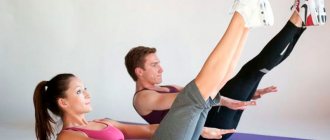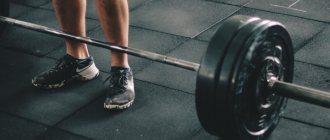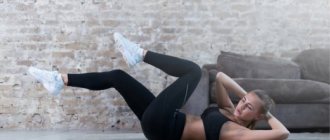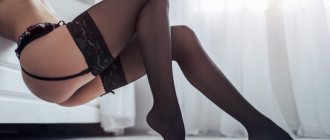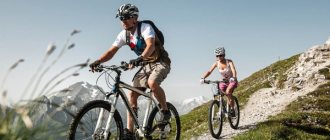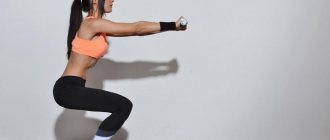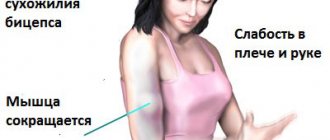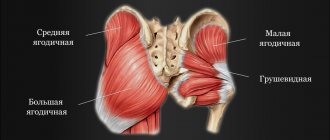How to pump up leg muscles[edit | edit code]
Each generation brings its own problems to bodybuilding. In the late forties, after ration cards and the desperate malnutrition of the wartime, nothing was more important for young people than a broad chest. The tailors, without hesitation, began to put cotton wool under the shoulders of their jackets. However, our sport very soon made this cartoonish fashion unnecessary for millions of young bodybuilders around the world. % The second half of the 20th century turned out to be relatively prosperous. Civilization gave its sons more and more benefits, but in return it took away the most important thing - physical movement. By the beginning of the new millennium, the planet’s lifestyle had finally become sedentary, giving rise to an unprecedented problem - massive atrophy of the muscles of the lower extremities.
How to deal with skinny and weak legs, i.e. how to pump up leg muscles? The old simple schemes, when everyone was advised to persistently “bomb” their legs with squats, alas, are no good. Here is the optimal training program. It consists of four different complexes, each of which specifically solves only one unique problem. By alternating complexes, you consistently eliminate one annoying shortcoming after another until you bring your legs to the desired ideal.
Each of the complexes is designed for a week. However, if solving the problem is difficult, extend the same training scheme for another week, or even three, until you finally defeat genetics. You will have to train your leg muscles twice a week, considering the “leg” workouts to be the main ones. As for the core muscles, here you deliberately need to work half-heartedly. Save energy!
The secret is that extreme pumping of the leg muscles is not only a matter of aesthetics, but also a cornerstone condition for success in training the entire muscle mass of the torso. The more powerful the leg muscles are, the lower the body’s center of gravity. Well, then the laws of physics will come to your aid. Thanks to the low center of gravity, you can radically increase the working weights in all standing exercises. Well, without powerful legs, they will remain frivolous, as will the result they cause.
How? Does the size of our biceps really depend on the strength of our legs? Exactly! So drop everything and start frantically pumping up your leg muscles! Build the foundation first, and only then dream about higher floors!
Exercise 4. Lean on the edge of the foot
Place one foot flat on the floor and the other on your toes. We will work with the first leg, and place the second on the toe to further increase the load on the first. Lift the inside edge of your foot on the first leg, moving your weight to the outside edge of your foot. Switch legs and repeat the same thing, lifting the inner edge of the foot that first stood on the toe.
Be careful: the leg should not fall to the side, the big toe remains in contact with the ground. If you perform the exercise correctly, you will train the tibialis posterior muscle. This muscle moves the foot inward and is not used during everyday walking. But if you put your foot too far on the outer edge, the ankle ligaments will stretch and the tibialis posterior muscle will turn off.
Weider's principles[edit | edit code]
- Practice these techniques for increasing the intensity of training in exercises, o. From the list of principles, choose one that works better for you than the rest, and use only one last set of exercises.
- Partial repetitions: After “failure,” perform as many “short” repetitions (at a quarter or half the amplitude) as you can. » Forced repetitions: After “failure,” your partner should help you overcome the initial part of the amplitude that is unbearable due to fatigue. Then you should do the rep on your own Do as many reps as you can.
- Drop sets: Once you reach failure, reduce the weight of the weight by 15-20% and do a new set until failure. If you feel strong, reduce the weight by another 5-10% and do an additional set until complete muscle failure.
- Rest-Pause: Choose a weight that you can only perform 2-3 reps with. Do the first set and rest for 20-25 seconds. Then perform another set of 2-3 repetitions and again rest for 20-25 seconds. In the presence of the insurer, try to overcome another set of 1-2 repetitions.
- High rep squats
A set of leg workouts
(how can it change as your training progresses)
Smell
- Squats 2x20-30 (size) + 3-4 x6-12
Spirit
- Squats 2x20-30 (size) + 3-4 x6-12
- Deadlift 1x20 (size) + 3-4x6-12
Elephant
- Squats 2x20-30 (size) + 3-4 x6-12
- Sitting extensions 1x20 (size) + 3-4x6-12
- Deadlift 1x20 (size) + 3-4x6-12
- Leg curls 1x20 (size) + 3-4 x 6-12
- Standing calves 1x20 (size) +3-4 x 10-20
Scoop
- Squats 2x20-30 (size) + 4 x6-12
- Sitting extensions 1x20 (size) + 4x6-12
- Deadlift 1x20 (size) + 4x6-12
- Leg curls 1x20 (size) + 4 x 6-12
- Standing calves 1x20 (size) +4 x 10-20
- Sitting calves 1x20 (size) +4 x 10-20
Grandfather
- Squats 2x20-30 (size) + 4 x6-12
- Leg press 1x20-30 (size) + 4 x6-12
- Sitting extensions 1x20 (size) + 4x6-12
- Deadlift 1x20 (size) + 4x6-12
- Leg curls 1x20 (size) + 4 x 6-12
- Standing calves 1x20 (size) +4 x 10-20
- Sitting calves 1x20 (size) +4 x 10-20
demobilization
- Squats 2x20-30 (size) + 5 x6-12
- Leg press 1x20-30 (size) + 5 x6-12
- Sitting extensions 1x20 (size) + 4x6-12
- Deadlift 1x20 (size) + 5x6-12
- Leg curls 1x20 (size) + 4 x 6-12
- Standing calves 1x20 (size) +5x 10-20
- Sitting calves 1x20 (size) +4 x 10-20
I hope you get the general idea, friends. It seems like I said all the main things. Oh yeah, rest between sets. In heavy exercises (squats, especially), the rest increases to about 2 minutes. In less time, you simply will not physically have time to recover. In other exercises, reduce the rest to 1-1.5 minutes. Don't forget to stretch your muscles while resting and you will be happy.
Low bar squats[edit | edit code]
Low Bar Squats Bottlenecks
:
bar position, head position.
Start:
Take a standing position as for classic squats. Bend your knees slightly. Turn your socks outward.
Performance:
Keeping your head straight, slowly lower yourself into a squat until you are parallel. At the bottom of the squat, make a distinct pause and slowly begin the rise. Here is the correct technique: as if a powerful force is pulling your head up, and your head is pulling your whole body along with it.
Error correction
: In squats, in addition to your legs, your back actively works. At the bottom of the squat, the body is strongly inclined, so it is the back muscles that help you straighten up at the end of the rise. Moreover, the largest muscles of the back receive a static load, but the small muscles of the lower back receive a dynamic load, and even equal to the total weight of the barbell. For most amateurs, the lower back is not very strong and therefore seriously limits the weight bearing. As a result, amateurs squat with a barbell that does not provide the necessary load to the leg muscles. They don’t see the benefits of the exercise and abandon it. Here's the solution: lower the bar low, almost to the middle of your traps. This will lower the center of gravity of the body and therefore significantly reduce the load on your back and lower back. The working weights will immediately become solid.
Why do my feet hurt?
There is a company in Switzerland that produces special shoes: they are designed to simulate walking on sand.
The company name, MBT, stands for Masai Barefoot Technologie. The technology for creating shoes is also called. The word Masai refers us to the African Maasai people, who have preserved their traditional way of life. This is no accident. The Maasai do not have many of the health problems that civilized city dwellers have. Among them, plano-valgus deformity of the feet is extremely rare, which most often brings us to the orthopedic office with complaints of pain in the feet. Part of the changes in this disease is flat feet: there is no bend in the sole between the toe and heel, and the entire plantar surface of the foot touches the ground. But that’s not all that happens to the foot with such deformation. The shin and heel are located not along the same axis, but in an X-shape, and the foot falls inward. Because of this, the load on the inner edge of the foot and on the base of the first toe increases. These parts of the foot become deformed, and the ligaments and tendons are overloaded. My feet start to hurt.
Why do our legs change this way? Part of the blame lies with a sedentary lifestyle. But the main reason is shoes.
Man began to use shoes for the sake of foot health: to protect them from the cold and from damage. But in doing so he harmed them. From early childhood, shoes constrain the joints in our feet and block their movement. When joints don't move, they don't send the signal to muscles to be active. And muscles that don't work become weak and atrophy. The more freely the feet develop, the better the muscles are developed. People from the Maasai tribes do not wear shoes - and their feet are much less likely to become deformed in the same way as ours.
This does not mean that we need to take off our slippers and walk around the apartment barefoot. The floor in the apartment is unnaturally flat: you simply won’t find such a smooth surface in nature. Uneven surfaces are important to keep your feet healthy (there's a reason why MBT shoes imitate walking on sand). When we walk on uneven surfaces, the unevenness irritates many receptors on the plantar side of the foot. Receptors signal the muscles in the foot to turn on and contract. The muscles are being trained. When contacting a flat surface, the foot does not receive many different signals, but one. Only a few muscles work - and so on over and over again. Muscles that are not activated when walking become weak and the foot begins to deform.
Romanian deadlift[edit | edit code]
Romanian Deadlift
Bottlenecks:
bar movement, back/head.
Start:
Remove the barbell from the supports at knee height and straighten up, holding the barbell at your hips.
Performance:
Keeping your back extremely straight, slowly lean forward. When the bar of the bar is approximately halfway up your shin, stop and immediately begin the reverse movement. Don't lift your head up. Keep it “in line” with your spine.
Error correction
: This exercise was invented by Romanian weightlifters, who once reigned supreme on the world weightlifting Olympus. The Romanian deadlift differs from the classic floor deadlift in that it has a limited amplitude. You lower the bar only to the middle of your shins. Thanks to this, the load on the lower back is reduced, and you can perform high-repetition rows without the risk of overloading and injuring the lower spine. The exercise purposefully develops the muscles of the back of the thighs and buttocks, but many amateurs deprive the exercise of its meaning by making an offensive mistake. They lower the barbell to the floor in a straight line. Well, in fact, the bar needs to be kept as close to the legs as possible. This reduces the load on the lower back and at the same time sends it precisely to the target leg muscles.
Read the main article:
Romanian deadlift
How can you tell if your feet are deformed?
There are only three main signs of planovalgus foot deformity. If there is at least one, this is a reason to think about a visit to an orthopedist.
- My legs get tired and hurt quickly.
Pain is associated with deformation if it appears during physical activity and does not bother you at night. Moreover, some places in the foot suffer more than others. First, the heel: the plantar fascia on the sole becomes chronically inflamed, and the heel hurts when walking, especially when taking the first steps in the morning. Secondly, the tendons that connect the joints in the big toe area: they also become inflamed and painful. - Calluses appeared on my feet.
The foot becomes deformed, the load when walking is distributed incorrectly, and calluses appear on the plantar surface. If you take them to a dermatologist, he will refer you to an orthopedist, because he himself can only cope with the symptoms: prescribe medications that soften the skin and promote its exfoliation. But the overload of the sole of the foot and the skin in this area will remain, and calluses will appear again. - The shoes became too small.
Our bones stop growing by age 22. Later, the leg increases in size only in two cases: if it swells or if the bones in it become deformed. In the second case, the forefoot usually widens, so shoes with a narrow toe feel especially tight and uncomfortable.
Leg extensions[edit | edit code]
Leg extensions
Bottlenecks:
foot position.
Start:
Adjust the position of the backrest so that the edge of the seat is directly under your knees. Sit on the machine and firmly grasp the side handles. Place your feet under the movable rollers.
Performance:
Slowly straighten your legs. At the end point, make a distinct pause, achieving an extreme contraction of the muscles of the front surface of the thighs. Slowly return the rollers to their original position. Do not allow the weight to rest on the support; keep it suspended.
Error correction:
Many amateurs consider extensions to be a purely auxiliary exercise. Meanwhile, extensions are the bodybuilder's main tool when it comes to giving the legs a powerful, athletic shape. It all comes down to the position of your feet. When you keep them parallel, the load is “sprayed” across the entire upper surface of the thighs. Since the load in the simulator is relatively small, this version is indeed ineffective. But if you spread your toes, the extensions will outline your kneecap with laser precision. If you bring it together, the load will be taken by the outer thighs, forming the so-called. "breeches". When performing extensions, the feet are held in a pre-fixed position or turned in the desired direction directly during movement.
Recommendations
- The two workouts should not be one after the other. It is ideal to leave a gap of four to five days between them.
- It is imperative to approach a set of exercises to develop strength only after performing joint gymnastics.
- The weights discussed in the article are worn exclusively on the ankles. You can also consider vests.
- There is no need to perform exercises if discomfort and pain are felt during movements.
- The working weight, the number of repetitions, as well as the duration and number of rounds are selected individually, based on the level of physical fitness and well-being on the day of training.
And also read: All exercises for legs → Exercises for developing arm strength →
Hack squats[edit | edit code]
Hack squats
Bottlenecks:
foot position
Start:
Take a position with your back resting on the cushion of the moving platform. Place your feet narrowly exactly in the middle of the supporting surface. Firmly grasp the stopper handles.
Performance:
Release the stoppers and take the weight of the platform onto your feet. Bend your knees and slowly lower yourself into a squat. When your thighs are parallel to the support surface, pause and push yourself up powerfully.
Error correction:
The regular version, with wide feet and pointed toes, targets the muscles in the front of the thighs. The back muscles are relieved of stress, as are the muscles of the back of the thighs and buttocks. However, this does not bring much benefit to the quadriceps. The movement is limited and isolated. In short, the simulator, as always, loses to the barbell. However, hack squats are indispensable as a targeted exercise for expanding the hips in the anterior projection. To do this, your feet need to be placed narrowly and, in addition, parallel to one another. The load will shift exactly to the outer areas of the quadriceps.
Exercise 1. Massage the foot with a roller
The secret ingredient in this exercise is a massage roller. This is a special rolling pin with pimples, which can be bought at an orthopedic salon or ordered online.
So, sit down and place the roller on the floor so that your feet can comfortably touch it. Roll your entire foot on the roller from toes to heel. Then the second one. This way you massage the foot, improve blood flow in it and prepare it for the next exercises.
Wall squats[edit | edit code]
Wall Squats
Bottlenecks:
correct technique
Start:
Take a position with your back against the wall. Bring your legs forward and spread wide. Take your socks apart. Hold a barbell plate to your chest with your hands.
Performance:
Without lifting your back from the wall, slowly slide down it, as if you were lowering yourself into the seat of a chair. In the bottom position, freeze for a moment and powerfully push yourself up the wall. At first, squat without additional weights, helping straighten your knees with your hands.
Error correction:
Creation of separation, i.e. deep separation of muscle bundles is a hell of a job. Wall squats are real torture. Sometimes this type of squat is performed with a large ball pressed against the wall with your back. This only makes the exercise less effective. It becomes easier to get down and up, but you still need to maintain balance. Well, this condition significantly limits the weight of additional burden.
Source Muscle and Fitness Magazine No. 1
Why don't my legs grow?
There are two main reasons:
- Or the legs are trained weakly (with little load and on “holidays”)
- Either the legs are trained too intensely and often (they overload the body with a heavy load)
And I immediately want to write: Awww, Denchik, what is the optimal load? Guys, how long can you say: THERE IS NO SUCH ONE! One for one, another for another. Today this load is not feasible for you and will drive you into a plateau, and in two years it will be too light. All this must be selected empirically, i.e. empirically.
Also, in continuation of the topic, I recommend reading the article Why your muscles don’t grow
Symptoms of growing pains in the legs
If your child has growing pains, he may say he has an aching or burning sensation in both legs—the muscles in his thighs, calves, or feet. Pain may also occur in the arms or other parts of the body, although this is much less common. Leg pain usually occurs at night and can sometimes even wake up the child. They are also common during the day, but are rarely so dangerous as to interfere with daily activities. For most children, leg pain or discomfort tends to come and go. It is difficult to say when such pain will begin and when it will go away. A child with growing pains in the legs will usually start on their own or allow the parent to massage the painful area. This can help determine the difference between growing pains and a more serious condition. Children whose leg pain is due to a more serious cause usually do not allow anyone to touch the painful area.
Restless legs syndrome - what is it?
Restless legs syndrome or Ekbom syndrome is a large group of diseases hiding behind typical clinical manifestations - nagging pain in the legs, a feeling of heat in the feet, aching sensations in the calves, intermittent swelling of the legs, and so on.
These sensations can be so intense that patients cannot sleep, seeking relief from suffering in night walks. The reasons for the development of this kind of condition can be different and the list of them is quite impressive: from hereditary metabolic disorders and intervertebral hernia, to chronic venous insufficiency and atherosclerosis of the arteries of the legs. Sometimes it is difficult not only for the patient, but also for the doctor to figure out what’s what. However, the problem of “restless legs”, no matter what causes it, has to be solved and, unfortunately, in some cases the matter does not end with general recommendations and strengthening procedures.
Treatment of growing pains in the legs
There is no specific treatment for growing pains.
You can tell your child that the pain is not serious and it will go away. Massaging or applying a heating pad to the affected area may help. Stretching your muscles and taking a warm bath before bed can also help. Sometimes your GP may offer your child some mild pain relief, such as paracetamol. There is no need to prevent your child from exercising. Growing pains usually go away with time. There is no cure for growing pains in the legs: there is nothing you can do to prevent growing pains in your child. Call a doctor at home Make an appointment with a doctor or call +7 (812) 331-17-74
Football leg training. Vladimir Chepzanovich – physical training coach of Spartak Moscow
In football, working with legs is perhaps the most complicated: a lot depends on the style of the team, the tournament, the characteristics of the player and his injury rate. For example, in the English Championship, where the defenders are as brutal as possible, the coaches force the fragile attackers to work in the gym. But it is important to distribute the load in such a way that David Silva does not overwork his muscles and lose the magic of his light legs, and Roberto Carlos does not lose the power for a long-range shot.
– How important is leg training day for football players?
– The so-called leg day in football is nonsense. The guys play football, this is their main job. This applies to any sport. Great knowledge is required in order to correctly dose and distribute loads.
– Some football players have powerful legs: for example, Roberto Carlos. But some have normal or even thin ones. How important is leg power?
– Leg power is, of course, very important in football, but some players have powerful legs purely genetically, like Carlos. It is not always enough for professionals to practice only strength: in addition to it, there are other types of training. Each club and academy has its own training philosophy - each player develops depending on this philosophy.
– What other types of training?
– The player works on speed, endurance, mobility, and tactical thinking. Based on this, there is an annual, monthly and weekly plan for strength work.
– Is there one leg training program for all football players or does each player have individual work?
– Everyone has an individual job. It is important for their physical fitness and injury prevention.
– What is better for football players: strength training or “high repetitions”?
– It all depends on the tasks in the educational and training process, on the preparation period. It is necessary to take into account the individual characteristics of the players. We have plans for different microcycles (annual and monthly). When we play three matches a week, we can't do that kind of training. Each workout has its own load and recovery time. You need to know physiology, biomechanics and the basics of sports training in order to understand what, how and when you can do.
– Is it possible for football players to squat with heavy weight?
– Squatting with heavy weights is possible, but it requires good technique. Based on recent research, you can squat with both free weight and a Smith machine. You always need to take into account the preparation period and the individual characteristics of the players: their body type, injury history, physical condition, etc.
– Who in Spartak squats the most weight?
– Each player has his own maximum weight, but we don’t chase records. It is not right. How can you compare a player who is 178 cm tall and weighs 75 kg with a football player whose height is 190 cm and weighs 88 kg? The one who squeezes or lifts more is stronger? It can't be compared.
Strength training is not needed for personal competitions; it is a serious and difficult part of the training process. They can either greatly help the player or cause great harm. The most important thing is technique.
– Wolverhampton star Adama Traore claims he works with his own weight and does not use barbells or dumbbells. He trains separately with the Olympic champion in running: in addition to working in resistance machines, he practices running training with sharp short-term accelerations. Is it more efficient than working with hardware?
– I am familiar with Adam’s types of training. He uses different options, but you need to understand in what period he performs this or that approach. The Internet does not always show the full picture of preparation, and incorrect conclusions can be drawn. Everything is very individual, but both options can give a good result.
– Does working with iron help in the fight against injuries?
– It can both help and harm. A very good knowledge of the coach is required to use iron: technique of execution, weight of weights, number of series, repetitions, preparation period, individual characteristics of players, and so on.
When planning strength work, you can help the player increase all indicators: speed, endurance, mobility. Unfortunately, many trainers do not know about this and do work for the sake of work. This has a negative impact on the players.
What symptoms are associated with leg pain?
Leg pain can affect only a small area of the leg, or it can affect most or even the entire leg. The pain can be dull or sharp, burning, tingling or dull. The child may experience pain in the buttocks, lower back, spine or foot.
Other signs and symptoms that may occur with leg pain include:
- swelling
- phlebeurysm
- wounds or ulcers
- redness, swelling, or warmth
- bad feeling
- change in color of a leg or foot
- slow healing wound

